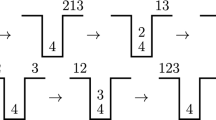Abstract
An (n, k) sequence covering array is a set of permutations of [n] such that each sequence of k distinct elements of [n] is a subsequence of at least one of the permutations. An (n, k) sequence covering array is perfect if there is a positive integer \(\lambda \) such that each sequence of k distinct elements of [n] is a subsequence of precisely \(\lambda \) of the permutations. While relatively close upper and lower bounds for the minimum size of a sequence covering array are known, this is not the case for perfect sequence covering arrays. Here we present new nontrivial bounds for the latter. In particular, for \(k=3\) we obtain a linear lower bound and an almost linear upper bound.




Similar content being viewed by others
Notes
Unless stated otherwise, all logarithms are in base 2.
References
Baker R., Harman G., Pintz J.: The difference between consecutive primes II. Proc. Lond. Math. Soc. 83(03), 532–562 (2001).
Chee Y., Colbourn C., Horsley D., Zhou J.: Sequence covering arrays. SIAM J. Discret. Math. 27(4), 1844–1861 (2013).
Colbourn C., Dinitz J.: Handbook of Combinatorial Designs, 2nd edn. CRC Press, New York (2006).
Füredi Z.: Scrambling permutations and entropy of hypergraphs. Random Struct. Algorithms 8(2), 97–104 (1996).
Gottlieb D.: A certain class of incidence matrices. Proc. Am. Math. Soc. 17(6), 1233–1237 (1966).
Ishigami Y.: Containment problems in high-dimensional spaces. Graphs Comb. 11(4), 327–335 (1995).
Ishigami Y.: An extremal problem of \(d\) permutations containing every permutation of every \(t\) elements. Discret. Math. 159(1–3), 279–283 (1996).
Kuhn D., Higdon J., Lawrence J., Kacker R., Lei Y.: Combinatorial methods for event sequence testing. In: Fifth International Conference on Software Testing, Verification and Validation (ICST), pp. 601–609. IEEE (2012).
Levenshtein V.: Perfect codes in the metric of deletions and insertions. Diskr. Mat. 1991, 3(1), 3–20; English translation: Discret. Math. Appl. 2(3), 241–258 (1992).
Mathon R., Van Trung T.: Directed t-packings and directed t-Steiner systems. Des. Codes Cryptogr. 18(1–3), 187–198 (1999).
Radhakrishnan J.: A note on scrambling permutations. Random Struct. Algorithms 22(4), 435–439 (2003).
Spencer J.: Minimal scrambling sets of simple orders. Acta Math. Hung. 22(3–4), 349–353 (1972).
Tarui J.: On the minimum number of completely 3-scrambling permutations. Discret. Math. 308(8), 1350–1354 (2008).
Wilson R.M.: A diagonal form for the incidence matrices of \(t\)-subsets vs. \(k\)-subsets. Eur. J. Comb. 11(6), 609–615 (1990).
Acknowledgements
The author thanks the referees for useful comments.
Author information
Authors and Affiliations
Corresponding author
Additional information
Communicated by C. J. Colbourn.
Publisher's Note
Springer Nature remains neutral with regard to jurisdictional claims in published maps and institutional affiliations.
Rights and permissions
About this article
Cite this article
Yuster, R. Perfect sequence covering arrays. Des. Codes Cryptogr. 88, 585–593 (2020). https://doi.org/10.1007/s10623-019-00698-7
Received:
Revised:
Accepted:
Published:
Issue Date:
DOI: https://doi.org/10.1007/s10623-019-00698-7




